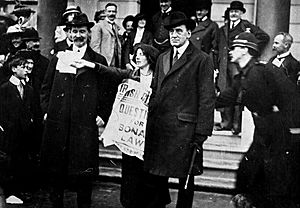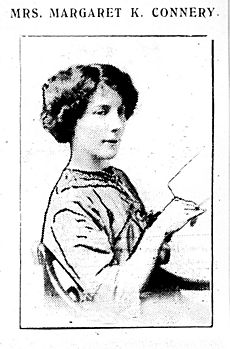Meg Connery facts for kids
Quick facts for kids
Margaret Connery
|
|
|---|---|

Connery attempting to hand suffragist literature to Bonar Law (left) and Edward Carson (right) in 1912
|
|
| Born |
Margaret Knight
1879 Westport County Mayo
|
| Died | 6 December 1958 Grangegorman, Ireland
|
| Nationality | Irish |
Meg Connery (1879–1956) was an important Irish activist. She worked hard to get women the right to vote. She was known as a suffragist organiser. A suffragist is someone who supports giving the right to vote to more people, especially women.
Contents
Early Life and Activism
Margaret Connery, born Margaret Knight, came from Westport, County Mayo. Her parents were John and Bridget Knight. She was the third of nine children. Her sister, Bridget, also worked for women's voting rights in America.
Meg's uncle, a Franciscan Friar, encouraged her to get an education. She married John Patrick 'Con' Connery when she was in her twenties. Not much is known about her life before she joined the Irish Women's Franchise League.
Meg Connery worked closely with Hanna Sheehy-Skeffington. She became the vice-chairwoman of the Irish Women's Franchise League. She was known for her strong activism. This included taking part in protests and working on The Irish Citizen newspaper. She even went to jail for her beliefs. People especially remember a photo of her. It shows her giving copies of The Irish Citizen to important leaders, Bonar Law and Sir Edward Carson.
Fighting for Women's Rights
Meg Connery believed that women should have the same rights as men. She felt it was wrong that society often had different rules for women and men. She wrote about these unfair "double standards" in The Irish Citizen newspaper.
She was often arrested for her protest actions. For example, she was jailed in November 1911 after a protest. In November 1912, she was part of a group that broke windows at the Custom House. She was also arrested in January 1913 for breaking windows at Dublin Castle. This time, she spent a month in prison.
While in prison in Tullamore, Meg and other women went on a hunger strike. This meant they refused to eat. They did this to demand that they be treated as political prisoners. This means they wanted to be seen as people jailed for their beliefs, not as regular criminals. The women eventually won their demand.
World War I and Beyond
During World War I, Meg Connery continued her activism. She protested against certain laws that affected women. In 1915, she chaired a protest meeting in Dublin. This was because Irish women were stopped from attending an international peace conference. The British government closed the North Sea, preventing them from traveling to The Hague.
In 1918, the Representation of the People Act was passed. This law gave some women the right to vote. However, Meg Connery felt it did not go far enough. She believed in full equality for all women. She continued to demand more rights.
Other Important Work
Meg Connery was also a member of the Irish Linen Worker's Union. She worked to make working conditions better for people. She also helped the Irish White Cross. In 1922, she was part of a group that looked at the damage caused by wars in Ireland. They visited places like Tipperary and Cork.
Meg Connery passed away in December 1958.
Images for kids
-
Connery attempting to hand suffragist literature to Bonar Law (left) and Edward Carson (right) in 1912



